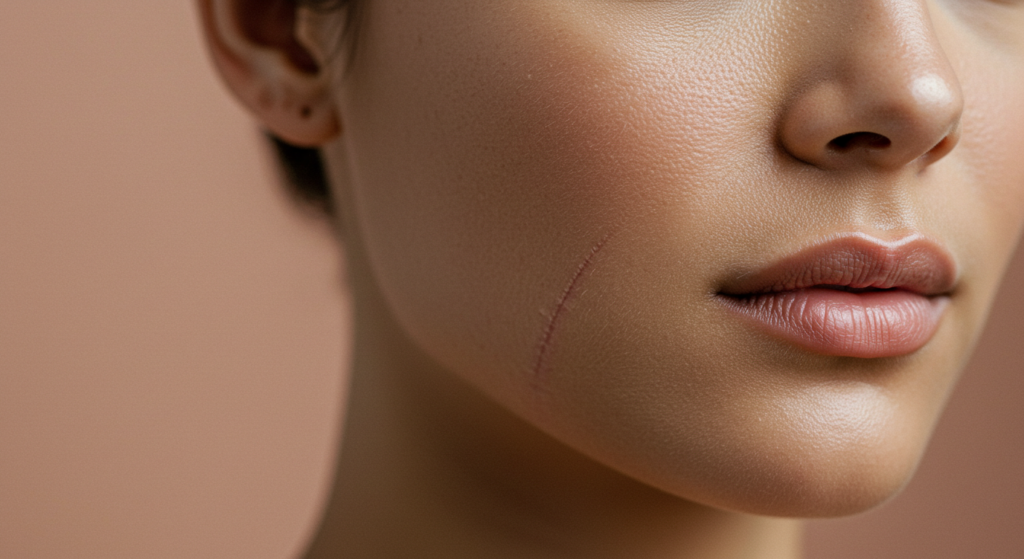For many transgender individuals considering Facial Feminization Surgery (FFS), the desire for a more feminine appearance is paramount. However, concerns about scarring are often a significant consideration. While surgical incisions are necessary to achieve bony and soft tissue reshaping in FFS, advancements in surgical techniques and post-operative care are increasingly focused on minimizing scarring and maximizing aesthetic outcomes, aiming for natural, harmonious, and beautifully feminine results with the least visible traces of surgery.
This article explores the strategies and techniques employed in FFS to minimize scarring and improve overall aesthetic outcomes for transgender individuals. We’ll delve into surgical approaches, scar management protocols, and the holistic principles of achieving natural and satisfying feminization.

Table of Contents
Understanding Scarring in FFS: Balancing Incisions and Outcomes
Scarring is an inevitable part of any surgical procedure involving incisions. It’s the body’s natural process of healing and repairing tissue. In FFS, incisions are necessary to access and reshape bone and soft tissues to create a more feminine facial structure.
Key Points about Scarring in FFS:
- Scarring is Unavoidable, but Minimizable: Incisions will always leave some degree of scarring. The goal is to minimize scar visibility, location, and prominence.
- Scar Quality Varies: Individual skin type, genetics, surgical technique, and post-operative care all influence scar quality.
- Scar Maturation Takes Time: Scars are dynamic and evolve over time. They typically appear most noticeable in the initial weeks and months after surgery, then gradually fade and soften over 12-18 months or even longer.
- Different Scar Types: Scars can range from fine, barely visible lines to hypertrophic scars (raised, red scars) or, rarely, keloid scars (thick, raised scars that extend beyond the original incision). Hypertrophic and keloid scars are less common in the face than on other parts of the body.
The focus in modern FFS is on strategically planning incisions, employing meticulous surgical techniques, and implementing comprehensive scar management protocols to achieve the best possible aesthetic outcomes with minimal visible scarring.
Surgical Techniques for Scar Minimization in FFS
Skilled FFS surgeons utilize various surgical techniques specifically designed to minimize scarring:
1. Strategic Incision Placement: The Art of Concealment
- Natural Skin Creases and Folds: Incision placement is carefully planned to utilize natural skin creases and folds whenever possible. For example, incisions for brow lifts or upper blepharoplasty can often be hidden within the upper eyelid crease.
- Hairline Incisions (Coronal Approach): For forehead contouring (especially brow bone reduction), a coronal incision placed along the hairline is commonly used. This 위치 enables excellent surgical access while allowing the scar to be mostly concealed within the hairline as hair regrows through it.
- Intraoral Incisions (Inside the Mouth): For procedures like chin contouring (genioplasty) or jaw angle reduction, incisions can often be placed inside the mouth (intraorally), leaving no visible external scars.
- Pre-tragal Incisions (in front of the ear): For some types of facelifts incorporated into FFS or temporal brow lifts, incisions may be placed in the pre-tragal crease (in front of the ear), which can become very well-concealed.
- Minimizing Incision Length: Surgeons strive to make incisions as short as practically possible while still allowing for adequate surgical access and visualization.
2. Minimally Invasive Techniques: Less is Often More (Where Applicable)
- Endoscopic Brow Lift: Endoscopic brow lift techniques utilize very small incisions within the scalp and an endoscope (a small camera) to perform brow elevation. This minimizes scarring compared to a traditional coronal brow lift.
- Limited Incisions for Forehead Contouring (Type 1 or Minor Cases): In cases of mild brow bossing or forehead refinement (Type 1 foreheadplasty), smaller incisions, sometimes even endoscopic approaches, may be feasible, reducing scar length. However, for significant brow bossing reduction (Type 3), a coronal incision typically remains necessary for optimal access and visualization.
Important Note: While minimally invasive techniques are valuable, the priority in FFS remains achieving effective and aesthetically pleasing feminization. In some cases, a slightly longer but strategically placed incision (like a coronal incision for Type 3 foreheadplasty) is necessary to achieve the desired bony reshaping and optimal feminization outcome. Scar minimization must be balanced with surgical efficacy.
3. Meticulous Surgical Technique: The Surgeon’s Touch
- Gentle Tissue Handling: Skilled surgeons employ meticulous surgical techniques, including gentle handling of tissues to minimize trauma and inflammation, which directly impacts scar formation.
- Layered Closure: Wound closure is typically performed in layers, carefully approximating each tissue layer (muscle, fat, skin) to reduce tension on the skin edges and promote finer scar formation.
- Tension-Free Closure: Surgeons utilize techniques to ensure wound edges are brought together without excessive tension, as tension is a major factor in wider and more prominent scar development.
- Fine Sutures and Suture Techniques: Fine sutures and meticulous suture placement, removal timing, and techniques contribute to less visible scars.

Advanced Scar Management Strategies: Optimizing Healing Post-Surgery
Post-operative scar care is absolutely essential to optimize scar healing and minimize visibility. Comprehensive scar management protocols are a standard part of FFS aftercare:
1. Early Wound Care and Hygiene
- Keeping the Incision Clean and Dry: Following the surgeon’s instructions for gentle wound cleaning and keeping the incision site dry is crucial in the initial healing phase to prevent infection and promote optimal healing environment.
- Antibiotic Ointments (Sometimes): Surgeons may recommend topical antibiotic ointments in the early days to prevent infection.
- Non-Adherent Dressings: Using non-adherent dressings prevents the dressing from sticking to the healing wound and causing trauma upon removal.
2. Silicone Sheeting or Gel: Hydration and Scar Flattening
- Silicone is Gold Standard: Topical silicone sheeting or gel is considered the gold standard for scar management. Silicone helps to hydrate the scar tissue, regulate collagen production, and flatten and soften scars.
- Start Early and Use Consistently: Silicone application is typically started once the incision is well-closed and sutures are removed, and used consistently for several months (often 2-3 months minimum, sometimes longer).
3. Scar Massage: Breaking Down Adhesions and Improving Texture
- Gentle Massage Technique: Once the incision is sufficiently healed (as advised by your surgeon), gentle massaging of the scar area is recommended. Massage helps to break down scar tissue adhesions, improve blood flow, and soften the scar texture.
- Timing and Technique Guidance: Your surgeon or their team will provide specific instructions on when to start scar massage and the appropriate technique.
4. Strict Sun Protection: Preventing Hyperpigmentation
- Sunlight Darkens Scars: UV radiation from sunlight can cause scars to become hyperpigmented (darker). Protecting the scar from sun exposure is critical.
- Sunscreen and Physical Barriers: Use high-SPF sunscreen (SPF 30 or higher, ideally SPF 50+) on the scar area daily, even on cloudy days. Physical barriers like hats and clothing should also be used for sun protection. Sun protection should continue for at least 12-18 months post-surgery, and ideally long-term scar management.
5. Laser and Light Therapies (Scar Revision – After Healing)
- For Persistent Redness or Prominent Scars: For scars that remain red, raised, or more visible even after initial healing, various laser and light therapies can be effective in scar revision. These are typically considered after the scar has matured for several months.
- Pulsed Dye Laser (PDL): Effective for reducing scar redness and vascularity.
- Fractional Lasers (e.g., Fraxel): Can improve scar texture, blend scar edges, and reduce overall scar prominence.
- Intense Pulsed Light (IPL): Can also help with scar redness and pigmentation issues.
- Consult with a Dermatologist or Scar Specialist: If considering laser scar revision, consult with a dermatologist or specialist experienced in scar lasers to determine the most appropriate treatment for your scar type and skin.
6. Corticosteroid Injections (For Hypertrophic Scars – Less Common in FFS Face)
- For Raised Scars: In the rare event of developing hypertrophic (raised) scars after FFS, corticosteroid injections directly into the scar can help to flatten and soften the raised scar tissue.
- Less Common in FFS Face Scars: Keloid and hypertrophic scarring are less frequently seen on the face compared to other body areas.
Maximizing Aesthetic Outcomes Beyond Scar Minimization: The Feminine ideal
Minimizing scarring is crucial, but achieving excellent aesthetic outcomes is the ultimate goal of FFS. This goes beyond just scar visibility and encompasses the overall feminine and natural appearance.
1. Natural Feminization is the Aim: Avoiding an “Operated” Look
- Subtle Refinement, Powerful Impact: The best FFS results are often characterized by natural-looking feminization, where changes may be subtle individually but create a significant overall feminine transformation without appearing “surgical” or “operated on.”
- Harmonious Facial Features: The goal is facial harmony, where all features – forehead, nose, jaw, chin, etc. – work together to create a balanced and feminine aesthetic, rather than focusing on individual features in isolation.
2. Customized Surgical Planning: Tailoring FFS to the Individual
- Unique Facial Anatomy: Every face is unique. Effective FFS requires a customized surgical plan tailored to each patient’s individual facial anatomy, bone structure, and feminization goals.
- Proportionality and Balance: Surgical plans should consider facial proportions, balance between features, and the overall desired feminine aesthetic for that specific individual.
3. Realistic Expectations and Patient-Surgeon Communication
- Open Dialogue and Shared Goals: Thorough pre-operative consultations and open communication between patient and surgeon are vital to establish realistic expectations and ensure shared understanding of aesthetic goals and limitations of surgery.
- Managing Expectations of “Perfection”: Surgery can achieve remarkable feminization, but it’s essential to understand that “perfection” is not realistic, and subtle asymmetries or minor imperfections are possible (and often natural).
- Focus on Improvement and Feminine Shift: Focus on the degree of feminization achieved and the overall shift towards a more feminine appearance, rather than striving for an unattainable ideal of flawlessness.
4. The Surgeon’s Skill and Aesthetic Eye: Artistry in Surgery
- Experience and Specialization: Choosing a surgeon who is highly experienced and specializes specifically in FFS is paramount for both scar minimization and optimal aesthetic outcomes.
- Aesthetic Sensibility: A skilled FFS surgeon possesses not only technical expertise but also a refined aesthetic eye – an understanding of feminine facial aesthetics, proportions, and natural beauty. This aesthetic sensibility is critical for achieving truly beautiful and natural-looking feminization.
Your Role in Aesthetic Success and Scar Management: Active Participation
As a patient, your active participation is crucial for both scar minimization and achieving optimal aesthetic outcomes:
- Choose Your Surgeon Wisely: Invest time and effort in researching and selecting a highly qualified and experienced FFS surgeon with a strong track record of excellent aesthetic results and a focus on scar minimization.
- Follow All Pre and Post-operative Instructions: Adherence to all pre- and post-operative instructions provided by your surgeon is non-negotiable for optimal healing, scar management, and overall surgical success.
- Maintain a Healthy Lifestyle: A healthy lifestyle, including not smoking, proper nutrition, and managing any underlying health conditions, promotes better healing and scar quality.
- Be Patient with Healing and Scar Maturation: Understand that healing and scar maturation are gradual processes that take time. Be patient and diligent with your scar care regime over the long term.
- Communicate with Your Surgical Team: Don’t hesitate to contact your surgeon’s office if you have any concerns about your healing, scar appearance, or aesthetic results at any point during your recovery. Early intervention can often address concerns effectively.
Conclusion – Achieving Feminine Beauty with Minimal Scarring for Transgenders: A Collaborative Journey
Minimizing scarring and achieving beautiful, natural aesthetic outcomes in FFS is a collaborative journey between the skilled surgeon and the informed, proactive patient. By understanding the principles of scar minimization, choosing a highly experienced surgeon, diligently following pre and post-operative instructions, and maintaining open communication, transgender individuals can significantly reduce scar visibility and maximize the aesthetic benefits of FFS.
Modern FFS, with its advancements in surgical techniques, scar management protocols, and a focus on holistic facial feminization, offers the promise of transformative changes with increasingly subtle and well-concealed traces of surgery. The goal – and increasingly the reality – is to achieve a naturally beautiful, feminine face that reflects your true gender identity, with confidence and minimal concern about scarring.
Ready to learn more about minimizing scarring and maximizing your aesthetic outcome with FFS? Schedule consultations with specialist Facial Feminization Surgeons today to discuss incision strategies, scar management protocols, and create a personalized surgical plan focused on both beautiful feminization and minimal visible scarring.
Visit Dr.MFO Instagram profile to see real patient transformations! Get a glimpse of the incredible results achieved through facial feminization surgery and other procedures. The profile showcases before-and-after photos that highlight Dr. MFO’s expertise and artistic vision in creating natural-looking, beautiful outcomes.
Ready to take the next step in your journey? Schedule a free consultation with Dr. MFO ( Best Facial Feminization Surgeon for You) today. During the consultation, you can discuss your goals, ask any questions you may have, and learn more about how Dr. MFO can help you achieve your desired look. Don’t hesitate to take advantage of this free opportunity to explore your options and see if Dr. MFO is the right fit for you.








